Engage NY Eureka Math 5th Grade Module 4 End of Module Assessment Answer Key
Eureka Math Grade 5 Module 4 End of Module Assessment Task Answer Key
Question 1.
Multiply or divide. Draw a model to explain your thinking.
a. \(\frac{1}{3}\) × \(\frac{1}{4}\)
Answer:
\(\frac{1}{12}\)
Explanation:
a. \(\frac{1}{3}\) × \(\frac{1}{4}\) = \(\frac{1}{12}\)
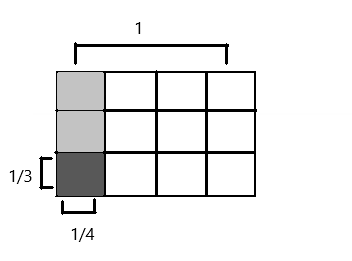
b. \(\frac{3}{4}\) × \(\frac{1}{3}\)
Answer:
\(\frac{3}{12}\)
Explanation:
b. \(\frac{3}{4}\) × \(\frac{1}{3}\) = \(\frac{3}{12}\)
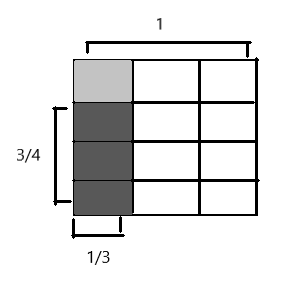
c. \(\frac{3}{4}\) × \(\frac{3}{5}\)
Answer:
\(\frac{9}{20}\)
Explanation:
\(\frac{3}{4}\) × \(\frac{3}{5}\) = \(\frac{9}{20}\)
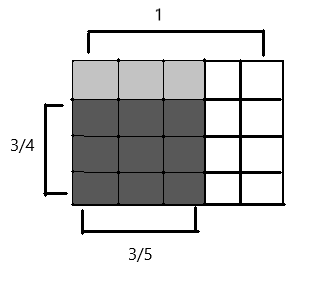
d. 4 ÷ \(\frac{1}{3}\)
Answer:
12
Explanation:
4 ÷ \(\frac{1}{3}\) = 12
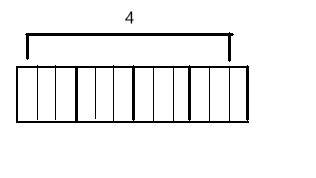
e. 5 ÷ \(\frac{1}{4}\)
Answer:
20
Explanation:
5 ÷ \(\frac{1}{4}\) = 20

5 ÷ 1/4 =20
f. \(\frac{1}{4}\) ÷ 5
Answer:
\(\frac{1}{20}\)
Explanation:
\(\frac{1}{4}\) ÷ 5 = \(\frac{1}{4}\)
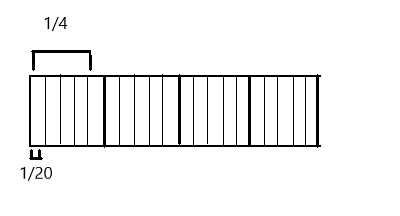
Question 2.
Multiply or divide using any method.
a. 1.5 × 32
Answer:
48.0
Explanation:
As solving the given question the answer we get is 480.
15 × 32 = 480
b. 1.5 × 0.32
Answer:
0.48
Explanation:
By solving the the given expression below the answer we get is 0.48
= ( 1×0.32) + (0.5×0.32)
= 0.32 + 0.16
= 0.48
c. 12 ÷ 0.03
Answer:
400
Explanation:
As solving the given expression the answer is 400.
(12×100) / (0.03×100)
1200 / 3
400
d. 1.2 ÷ 0.3
Answer:
4
Explanation:
By solving the given expression the answer we get is 4.
(1.2×10) / (0.3×10)
12 / 3
4
e. 12.8 × \(\frac{3}{4}\)
Answer:
9 3/5
Explanation:
By solving the given expression the answer we get is 9 3/5
(12 × 3/4) + ( 8/10 × 3/4)
9 + 24/40
9 24/40
9 3/5
f. 102.4 ÷ 3.2
Answer:
32
Explanation:
By dividing the given expression the answer we get is 32
(102.4 ×10) / (3.2 ×10)
1024 / 32
32
Question 3.
Fill in the chart by writing an equivalent expression.
| a. | One-fifth the sum of one-half and one-third | 1/5 × (1/2 +1/3) |
| b. | Two and one-half times the sum of nine and twelve | 2 1/2 × (9 +12) |
| c. | Twenty-four divided by the difference between and | 24 ÷ ( 1 1/2 – 3/4) |
Explanation:
I have filled the chart by writing an equivalent expression given in the question
Question 4.
A castle has to be guarded 24 hours a day. Five knights are ordered to split each day’s guard duty equally. How long will each knight spend on guard duty in one day?
a. Record your answer in hours.
Answer:
4.8 hours
Explanation:
Each knight will spend 4.8 hours on guard duty in one day by dividing 24/5 = 4.8 hrs
b. Record your answer in hours and minutes.
Answer:
4 hrs 48 minutes
Explanation:
1/10 of 60 min = 6 min
8/10 of 60 min = 48 min
Here in this, each knight will spend 4 hours and 48 minutes on guard duty in one day.
c. Record your answer in minutes.
Answer:
288 minutes
Explanation:
4.8 hour = 4.8 × 1 hr
= 4.8 × 60 min
= 288.0 min
Here, Each Knight will spend 288 minutes on guard duty in one day.
Question 5.
On the blank, write a division expression that matches the situation.
a. _________________ Mark and Jada share 5 yards of ribbon equally. How much ribbon will each get?
Answer:
5 ÷ 2
Explanation:
Mark and Jada get 5 ÷ 2 ribbons each
b. _______ It takes half of a yard of ribbon to make a bow. How many bows can be made with 5 yards of ribbon?
Answer:
5 ÷ 1/2
Explanation:
5 ÷ 1/2 bows can be made with 5 yards of ribbon.
c. Draw a diagram for each problem and solve it.
d. Could either of the problems also be solved by using \(\frac{1}{2}\) × 5? If so, which one(s)? Explain your thinking.
Answer:
5 ÷ 2 = 5×1/2
Explanation:
In this question dividing by 2 is the same as taking 1/2 of something, which means multiplying. Hence 1/2 × 5 is the same as 5 × 1/2.
Question 6.
Jackson claims that multiplication always makes a number bigger. He gave the following examples:
- If I take 6, and I multiply it by 4, I get 24, which is bigger than 6.
- If I take \(\frac{1}{4}\), and I multiply it by 2 (whole number), I get \(\frac{2}{4}\), or \(\frac{1}{2}\), which is bigger than \(\frac{1}{4}\).
Jackson’s reasoning is incorrect. Give an example that proves he is wrong, and explain his mistake using pictures, words, or numbers.
Answer:
1/2 × 1/3 = 1/6
1/6 is smaller than 1/2 and 1/3
Explanation:
Question 7.
Jill collected honey from 9 different beehives and recorded the amount collected, in gallons, from each hive in the line plot shown:

a. She wants to write the value of each point marked on the number line above (Points A–D) in terms of the largest possible whole number of gallons, quarts, and pints. Use the line plot above to fill in the blanks with the correct conversions. (The first one is done for you.)
A. 0 gal 3 qt 0 pt
B. _______ gal ______ qt _______pt
Answer:
1 gal 2 qt 0 pt
C. _______ gal ______ qt _______pt
Answer:
2 gal 0 qt 1 pt
D. _______ gal ______ qt _______pt
Answer:
2 gal 2 qt 1 pt
b. Find the total amount of honey collected from the five hives that produced the most honey.
Answer:
13 1/8 gallons
Explanation:
1 unit = 2 5/8 gallons
5 unit = 5×2 5/8 gallons
= ( 5×2) + ( 5× 5/8) gallons
= 10 + (25/8) gallons
= 10 + 3 1/8 gallons
= 13 1/8 gallon
c. Jill collected a total of 19 gallons of honey. If she distributes all of the honey equally between 9 jars, how much honey will be in each jar?
Answer:
2 1/9 gallons
Explanation:
19÷9 = 19/9
2 1/9
After she distributed all of the honey equally there will be 2 1/9 gallons of honey in each Jar.
d. Jill used \(\frac{3}{4}\) of a jar of honey for baking. How much honey did she use baking?
Answer:
1 7/12 gallons
Explanation:
3/4 of 2 1/9 gallons
3/4 × 19/9 gallons
19/12
1 7/12 gallons
After Jill used a jar of honey for baking she used 1 7/12 gallons of honey for baking.
e. Jill’s mom used \(\frac{1}{4}\) of a gallon of honey to bake 3 loaves of bread. If she used an equal amount of honey in each loaf, how much honey did she use for 1 loaf?
Answer:
1/12
Explanation:
1/4 ÷ 3 = 1/4 × 1/3
1/12
She used 1/12 of a gallon of honey for 1 loaf.
f. Jill’s mom stored some of the honey in a container that held \(\frac{3}{4}\) of a gallon. She used half of this amount to sweeten tea. How much honey, in cups, was used in the tea? Write an equation, and draw a tape diagram.
Answer:
6 cups
Explanation:
1/2 × 3/4 gallon = 3/8 gallon
3/8 gallon = 3/8 × 1 gallon
= 3/8 × 16 cups
= 6 cups
Hence she used 6 cups of honey in the Tea.
g. Jill uses some of her honey to make lotion. If each bottle of lotion requires \(\frac{1}{4}\) gallon, and she uses a total of 3 gallons, how many bottles of lotion does she make?
Answer:
12 bottles
Explanation:
3÷1/4 = 3 × 4 =12
Hence she makes 12 bottles of lotion.